Stone types
The stones were made of
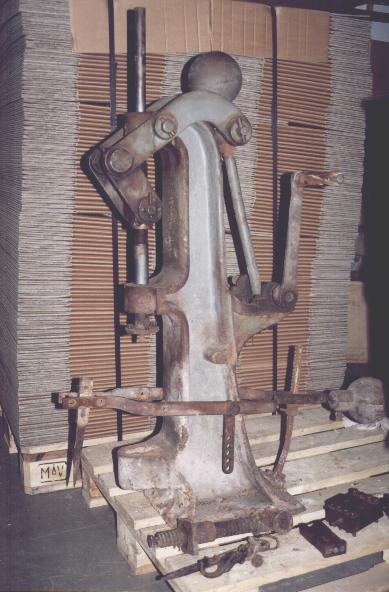
sand, finely ground chalk, plus colouring, that was mixed with linseed oil varnish. The technology is unchanged in the past 130 years, up to the day. Production procedure is not much more complex today than the early days' manufactural way, and it is mainly the method invented by the Lilienthal brothers in the 1870s.
In 1995, when the factory restarted, the change of the press machines had to take place only because the storing conditions weren't the best between the closing up in 1963 and the reopening in 1995.
The technology is fairly simple. First the metal molds are filled with the sand, chalk, and colouring material mixture. Then it is mixed with linseed oil varnish. Finally, the air bubbles are pressed out of the forms with the help of a high pressure tool. Finally, it is baked for eight days at 100-150 degrees Celsius.
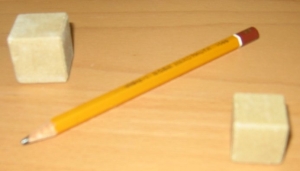
The original Lilienthal system was based on a cube that had a 2 cm edge. During the further product development, Richter enlarged the product tree with a new series of blocks, that had a 2,5 cm edge length.
Through tradition, we name the 2 cm blocks "small caliber"(Kleinkaliber - KK) , and the bigger ones as "large caliber" (Grosskaliber - GK). We only mention here that mosaics and puzzles were also made of the same materials as the building blocks.
The production process started with the KK stones, but sales have shown fairly early that GK sets are more popular. As a result, the production of KK stones stopped in 1915.
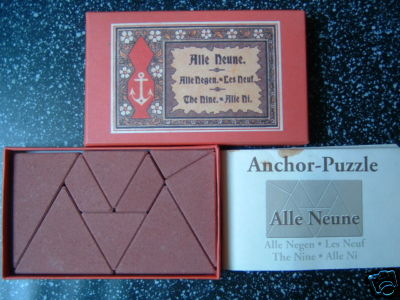
The total product palette of KK sets was of 86 types.
The development of GK sets hasn't been discontinued after WW I. We know to the day about 438 types of GK sets.
Remember that development of the building block sets started prior to 1884. There was nothing like talkative product numbering, softwares handling large databases, IT experience in data processing, etc.
The first ones were two KK series and a GK series of sets. Not even Richter himself could have thought the production would last more than 80 years, and the number of stones produced would be of billions.
A set met all the epoch's requirements. In comparison, let us think about some of the
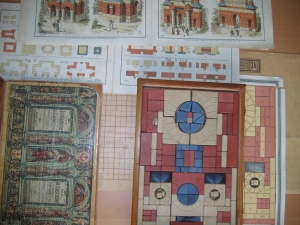
far eastern industry's representative products. Considering the outlook and durability both, the present day products don't come out winners. The old building block sets were made to last, no material was spared. The view was that a bit more expensive materials would be more exigent, and above all, more lasting, thus being more profitable than any cheap products. It is fair to mention that the far eastern "use then drop" type of mass production wasn't fashionable in those days.
The Richter-make sets were made all of quality materials: wooden box, heavy paper. Except for a few cardboard box starter sets, the usual outfit was:
- wooden box with metal corners
- drawing for the placing of stones in the box
- building designs for the specific set and for the previous, smaller sets
- building grid (for easier placement of the first stone layer)
- printed cardboard figurines to make buildings more aesthetic
- and finally, but most importantly, the stones themselves
The building plans were drawn by the epoch's renown artists. Their building plans were a worthy pair to the sets. The booklet also served with advices for building. The language is pompous and archaic. It is quite fun reading the useful words:
The best proof that a genuine Anchor stone building set excites the spirit of children in a most wholesome way, indisputably lies in the fact that they all have the desire to execute the larger buildings; for these buildings go still further into the art of building. That this commendable aspiration of the small master builder finds support from all reasonable parents, we have observed from the surprisingly good reception which has been received by the supplement sets introduced by the factory. With them every Anchor
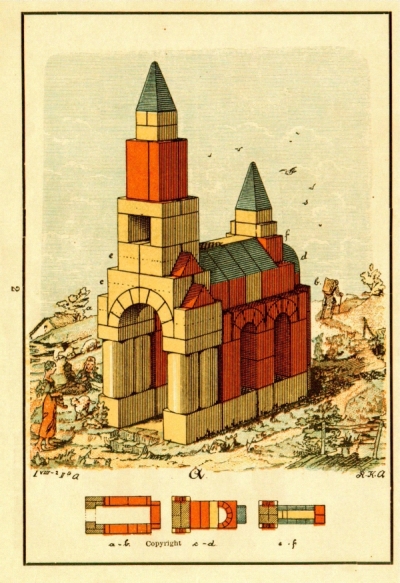
stone building set can be enlarged on a regular basis. For example, whoever owns set # 5 needs only to buy the supplement set # 5A and he then has exactly the same stones and plans that are found in the large set # 9. And how much larger and more beautiful
are the buildings, which can be made after the purchase of the supplement set, is shown to the reader by the facade of the city hall, on page 16 of this plan book.
A larger box contained several hundred larger or smaller stones. The bigger sets contained several layers, that could be moved with the help of handles. The stones were arranged in these trays. The container box sometimes was an entire wardrobe, that weighed more than a hundred kilos.
The basics of the product palette is very simple: a basic set plus a supplement set resulted in a larger basic set. The transition between different series was possible with the help of conversion sets.
The simple theoretic picture is puzzled by the fact that certain boxes do not convert anywhere, though they are conversion sets. Some sets were designed, their content settled, the packing plans drawn, then never produced. Some basic sets were never sold as such, only as smaller basic sets plus supplement sets. The shop owner of the time had a book as aid to be able to help a customer in what type of set to purchase.
The picture in the right shows a wardrobe-like large caliber set containing 3,848 stones. The first set in the series, GK-NF 2 is shown on the "History of the stones" page. The pile of supplement
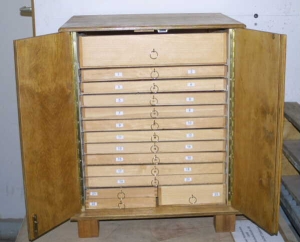
sets leads to this set, the GK-NF 34.
The situation clearly didn't become simpler, since metal parts started being produced. When building larger models, these metal parts were used to cover the designs instead of many and heavy stones. Man can imagine what an explosion of conversion sets resulted.
The series were as follows:
AF (Alte Folge) - old series: the first sets produced
NF (Neue Folge) - new series: following a period of product development, these sets were introduced in 1894
Br (Brückenteile) - bridge series: sets containing stones and metal bridge elements (only as supplements to the NF series sets)
Im (Imperator) - bridge series: like the previous, except the fact that Im sets were basic sets
A-B (Anker Blocks) - bridge sets only sold in the US
VE (Vernickelte Eisenteile) - sets containing stones and metal parts for making roofs
DS (Dachsteine) - XXXXXX: stones sets containing a roof system composed of a metal grid on which man could place stone plates
NS (Neue Serie) - new series: sets containing only stones, and modified arches
LE (Lackierte Eisenteile) - sets containing only the metal parts for bridges and roofs (no stones included)
DB (Dachbaukasten) - sets only containing metal parts used to make roofs and the stone plates (no stones included)
NR100 (Neue Reihe) - new series: sets that could be used to make specific buildings
NR200 (Modern House - American Bungalow) - new series: sets used to build American bungalow type houses
NR300 (German Country House - Landhaus) - new series: sets used to build German country houses
NR400 (Fortress - Festung) - new series: sets used to build fortresses
From the series enlisted above, only the AF, NF, Br series were available in small and large caliber. The rest, from the Im series below were only GK series. Due to this, it makes sense to specify whether a set is KK-AF or GK-AF. Naming a set as GK-DS is not necessary, since the DS series were only produced using GK sets.
An example to the product palette system is the following: the basic set KK-AF 4 plus the supplement set resulted in the basic set KK-AF 8. If man added the conversion set KK-AF 4A to the set KK-AF 4, then it resulted in the KK-NF 5 set.
Another example: basic set GK-DS 9 + supplement DS 9A = basic set DS 11. Adding the GK 9U conversion set resulted in the basic set GK-NF 10.
The re-started factory only produces GK-NF series sets.
A picture of the entire range of sets can be found on the "Downloads" page.
The packing plan of almost all the sets can be found on the following web page: cva.flying-cat.de.
The most part of these scans was made by George F. Hardy, the home page is taen care of by Burkhard Schultz.